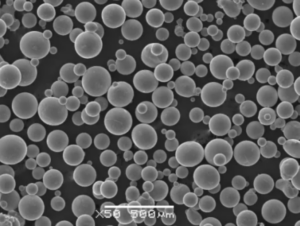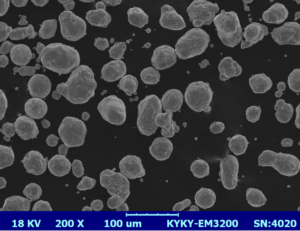Visão geral do Powder for Impressão de Formato Grande
A impressão de formato grande revolucionou as indústrias, da publicidade à modelagem arquitetônica, permitindo a criação de imagens detalhadas e vibrantes em grande escala. Mas você sabia que um dos elementos-chave nesse processo é o tipo de pó utilizado? Seja você um profissional experiente ou apenas curioso sobre como funciona a impressão de formato grande, a compreensão do papel do pó pode impactar significativamente a qualidade e a durabilidade de suas impressões. Neste guia, vamos mergulhar no mundo dos pós utilizados na impressão de formato grande, com foco em pós metálicos e suas aplicações específicas.
Exploraremos vários modelos de pó metálico, suas composições, características e as vantagens que oferecem. Com uma compreensão completa desses materiais, você pode tomar decisões informadas que aprimoram seus projetos de impressão. Pronto para mergulhar? Vamos começar!
O que é Pó para Impressão de Formato Grande?
Na impressão de formato grande, o uso de pó é crucial para obter a qualidade de impressão, textura e durabilidade desejadas. Os pós são partículas finamente moídas que são aplicadas em camadas, geralmente por meio de um processo chamado sinterização seletiva a laser (SLS) ou jato de aglutinante. Esses pós podem ser compostos de vários materiais, incluindo metais, cerâmicas e polímeros, cada um oferecendo propriedades únicas adequadas para diferentes aplicações.
Neste artigo, focaremos especificamente em pós metálicos, que são essenciais para criar impressões fortes, duráveis e intrincadas. Os pós metálicos são particularmente favorecidos em indústrias como aeroespacial, automotiva e dispositivos médicos devido à sua capacidade de produzir componentes de alta resistência com geometrias complexas.
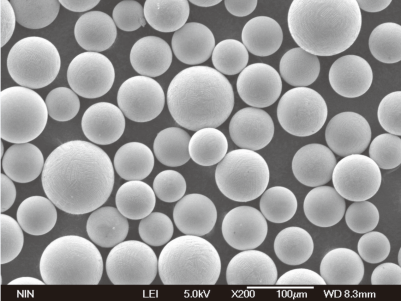
Tipos de pós metálicos para Impressão de Formato Grande
A escolha do tipo certo de pó metálico é crucial para obter resultados ótimos na impressão de grande formato. Abaixo, apresentamos alguns dos modelos de pó metálico mais populares, destacando sua composição, propriedades e aplicações adequadas.
| Pó metálico | Composição | Propriedades | Formulários |
|---|---|---|---|
| Aço inoxidável 316L | Ferro, cromo, níquel | Alta resistência à corrosão, excelentes propriedades mecânicas | Aeroespacial, dispositivos médicos, peças automotivas |
| Inconel 718 | Níquel, cromo, ferro | Alta resistência, resistência ao calor, resistência à oxidação | Lâminas de turbinas, motores de foguetes, ambientes de alta temperatura |
| Alumínio AlSi10Mg | Alumínio, silício, magnésio | Leve, boa condutividade térmica, alta relação resistência-peso | Automotivo, aeroespacial, componentes leves |
| Titânio Ti64 | Titânio, alumínio, vanádio | Alta resistência, baixo peso, biocompatibilidade | Implantes médicos, componentes aeroespaciais, equipamentos esportivos de alto desempenho |
| Cobre | Cobre puro | Excelente condutividade elétrica, alta condutividade térmica | Componentes elétricos, trocadores de calor, elementos decorativos |
| Aço ferramenta H13 | Ferro, Carbono, Cromo, Molibdênio, Vanádio | Alta dureza, resistência ao desgaste, resistência ao calor | Moldes de injeção, ferramentas de fundição sob pressão, ferramentas de corte |
| Cobalto-cromo (CoCr) | Cobalto, cromo, molibdênio | Alta resistência ao desgaste, biocompatibilidade, resistência à corrosão | Implantes odontológicos, implantes ortopédicos, componentes aeroespaciais |
| Bronze | Cobre, estanho | Boa resistência ao desgaste, acabamento esteticamente agradável | Esculturas, elementos arquitetônicos, rolamentos |
| Liga de níquel 625 | Níquel, cromo, molibdênio, nióbio | Alta resistência, excelente resistência à fadiga e fadiga térmica | Aplicações marítimas, processamento químico, reatores nucleares |
| Aço Maraging (MS1) | Ferro, níquel, cobalto, molibdênio | Alta resistência, excelente usinabilidade, estabilidade dimensional | Ferramentas, aeroespacial, componentes de alta resistência |
Composição do Pó para Impressão de Grande Formato
A composição do pó é um fator crucial que determina sua adequação para aplicações específicas. Diferentes composições oferecem níveis variados de resistência, flexibilidade e resistência a fatores ambientais como calor, corrosão e desgaste.
| Pó metálico | Elementos primários | Aditivos | Propriedades Derivadas da Composição |
|---|---|---|---|
| Aço inoxidável 316L | Ferro, cromo, níquel | Manganês, silício | Resistência à corrosão aprimorada, tenacidade |
| Inconel 718 | Níquel, cromo, ferro | Molibdênio, Nióbio | Resistência superior a altas temperaturas e resistência à corrosão |
| Alumínio AlSi10Mg | Alumínio, silício, magnésio | Cobre | Relação resistência-peso aprimorada, boas propriedades de fundição |
| Titânio Ti64 | Titânio, alumínio, vanádio | Ferro | Alta resistência, baixa densidade, biocompatibilidade |
| Cobre | Cobre puro | – | Excelente condutividade elétrica e térmica |
| Aço ferramenta H13 | Ferro, carbono, cromo | Molibdênio, Vanádio | Dureza e resistência ao calor aprimoradas |
| Cobalto-cromo (CoCr) | Cobalto, cromo | Molibdênio | Alta resistência ao desgaste, biocompatibilidade |
| Bronze | Cobre, estanho | Zinco, Chumbo | Boa usinabilidade, resistência ao desgaste |
| Liga de níquel 625 | Níquel, Cromo | Molibdênio, Nióbio | Excelente resistência à fadiga, alta resistência |
| Aço Maraging (MS1) | Ferro, níquel, cobalto | Molibdênio, Titânio | Alta tenacidade, capacidades de endurecimento por envelhecimento |
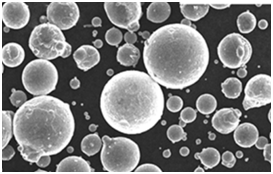


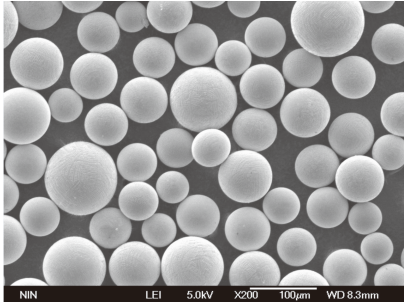
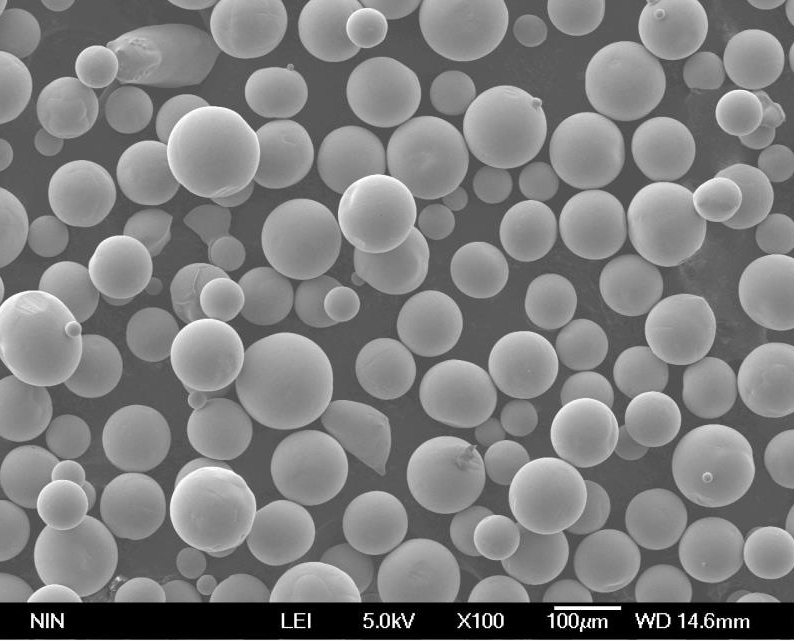
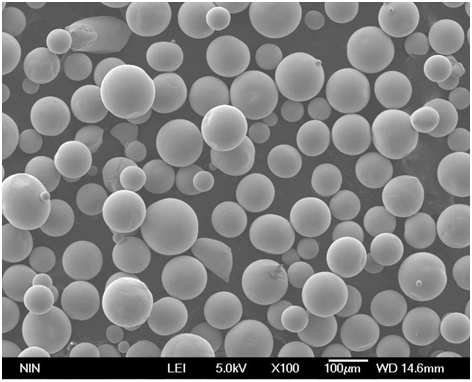
Características do Pó para Impressão de Formato Grande
Compreender as características dos diferentes pós é essencial para selecionar o material certo para as suas necessidades de impressão. Características como tamanho de partícula, forma e capacidade de fluxo podem afetar a qualidade e consistência da impressão final.
| Característica | Importância na Impressão | Exemplo de Pó Metálico | Detalhes |
|---|---|---|---|
| Tamanho da partícula | Afeta o acabamento da superfície e a resolução dos detalhes | Aço inoxidável 316L | Partículas mais finas produzem superfícies mais lisas |
| Forma da partícula | Influencia a capacidade de fluxo e a densidade de empacotamento do pó | Alumínio AlSi10Mg | Partículas esféricas melhoram a capacidade de fluxo |
| Fluidez | Impacta a uniformidade das camadas de pó | Titânio Ti64 | Boa capacidade de fluxo garante a deposição consistente das camadas |
| Pureza | Determina as propriedades mecânicas e o desempenho | Inconel 718 | Pós de alta pureza levam a melhores propriedades mecânicas |
| Densidade | Afeta o peso e a integridade estrutural da impressão | Aço Maraging (MS1) | Pós de maior densidade produzem peças mais fortes |
| Resistência à oxidação | Crítico para aplicações em ambientes agressivos | Liga de níquel 625 | Alta resistência à oxidação prolonga a vida útil dos componentes |
| Condutividade térmica | Importante para a dissipação de calor em componentes | Cobre | Alta condutividade térmica ideal para permutadores de calor |
Aplicações do Pó para Impressão de Grande Formato
Os pós metálicos são usados numa ampla gama de aplicações, desde a aeroespacial e automotiva até as artes médicas e decorativas. A tabela abaixo destaca algumas das aplicações mais comuns para os vários pós metálicos usados na impressão de grande formato.
| Aplicativo | Pó metálico | Por que é Usado |
|---|---|---|
| Componentes aeroespaciais | Titânio Ti64, Inconel 718 | Alta resistência, leveza, resistência ao calor |
| Implantes médicos | Cobalto-Cromo (CoCr), Titânio Ti64 | Biocompatibilidade, resistência à corrosão |
| Peças automotivas | Alumínio AlSi10Mg, aço inoxidável 316L | Leve, de alta resistência e resistente à corrosão |
| Ferramentas | Aço para Ferramentas H13, Aço Maraging (MS1) | Alta dureza, resistência ao desgaste, durabilidade |
| Componentes elétricos | Cobre | Excelente condutividade elétrica |
| Trocadores de calor | Cobre, Liga de Níquel 625 | Alta condutividade térmica, resistência à corrosão |
| Esculturas e Artes Decorativas | Bronze | Acabamento estético, boa resistência ao desgaste |
| Lâminas da turbina | Inconel 718, Liga de Níquel 625 | Alta resistência, resistência à oxidação |
| Ferramentas de Fundição Sob Pressão | Aço ferramenta H13 | Alta resistência ao calor, durabilidade |
| Artigos esportivos | Titânio Ti64 | Leve e de alto desempenho |
Especificações, tamanhos e padrões
Ao selecionar pós metálicos para impressão de grande formato, é essencial considerar as especificações, tamanhos e padrões para garantir a compatibilidade com o seu equipamento de impressão e os requisitos da aplicação.
| Pó metálico | Especificações | Faixa de tamanho de partícula (µm) | Padrões |
|---|---|---|---|
| Aço inoxidável 316L | ASTM A276 | 15-45 | ISO 5832-1 |
| Inconel 718 | AMS 5662 | 20-63 | ASTM B637 |
| Alumínio AlSi10Mg | ASTM B209 | 20-60 | ISO 3522 |
| Titânio Ti64 | ASTM F136 | 15-45 | ISO 5832-3 |
| Cobre | ASTM B170 | 10-50 | ISO 1338 |
| Aço ferramenta H13 | ASTM A681 | 15-53 | ISO 4957 |
| Cobalto-cromo (CoCr) | ASTM F1537 | 15-45 | ISO 5832-4 |
| Bronze | ASTM B22 | 20-63 | ISO 19701 |
| Liga de níquel 625 | AMS 5666 | 20-45 | ASTM B443 |
| Aço Maraging (MS1) | AMS 6512 | 15-53 | ISO 4957 |
Detalhes de fornecedores e preços
O mercado de pós metálicos é vasto, com inúmeros fornecedores que oferecem vários graus e especificações. O preço pode variar dependendo de fatores como pureza, tamanho das partículas e quantidade comprada.
| Fornecedor | Pó metálico | Faixa de Preço (US$ por kg) | Comentários |
|---|---|---|---|
| Sandvik Osprey | Aço inoxidável 316L | $70 – $100 | Pó de alta qualidade, tamanho de partícula consistente |
| Höganäs | Inconel 718 | $150 – $200 | Excelente desempenho em altas temperaturas |
| Tecnologia LPW | Alumínio AlSi10Mg | $90 – $120 | Bem adequado para aplicações leves |
| AP&C | Titânio Ti64 | $200 – $250 | Alta pureza, biocompatível |
| Tekna | Cobre | $80 – $110 | Ideal para aplicações elétricas e térmicas |
| Tecnologia Carpenter | Aço ferramenta H13 | $100 – $130 | Dureza superior e resistência ao calor |
| EOS | Cobalto-cromo (CoCr) | $180 – $220 | Alta resistência ao desgaste, biocompatibilidade |
| Aditivo GKN | Bronze | $50 – $70 | Acessível, boa resistência ao desgaste |
| Velo3D | Liga de níquel 625 | $140 – $180 | Excelente resistência à fadiga |
| Pós e revestimentos avançados | Aço Maraging (MS1) | $120 – $160 | Alta resistência, fácil usinagem |
Comparando Prós e Contras de Pós Metálicos
Cada pó metálico tem suas vantagens e limitações, dependendo da aplicação. Aqui está uma comparação de alguns dos principais prós e contras dos pós metálicos discutidos.
| Pó metálico | Vantagens | Desvantagens |
|---|---|---|
| Aço inoxidável 316L | Alta resistência à corrosão, boas propriedades mecânicas | Relativamente pesado, menor condutividade térmica |
| Inconel 718 | Alta resistência em temperaturas elevadas, resistência à oxidação | Caro, difícil de usinar |
| Alumínio AlSi10Mg | Leve, com boa condutividade térmica | Menor resistência em comparação com outros metais |
| Titânio Ti64 | Alta relação resistência/peso, biocompatibilidade | Caro, difícil de trabalhar |
| Cobre | Excelente condutividade elétrica e térmica | Propenso à oxidação, relativamente macio |
| Aço ferramenta H13 | Alta dureza, resistência ao desgaste | Frágil em baixas temperaturas, caro |
| Cobalto-cromo (CoCr) | Alta resistência ao desgaste, biocompatibilidade | Difícil de usinar, caro |
| Bronze | Boa resistência ao desgaste, esteticamente agradável | Resistência relativamente baixa, propenso a manchas |
| Liga de níquel 625 | Excelente resistência à fadiga e à corrosão | Caro, pesado |
| Aço Maraging (MS1) | Alta resistência, excelente usinabilidade | Caro, suscetível à corrosão em certos ambientes |

Perguntas frequentes
Qual é o pó metálico mais comumente usado para impressão de grande formato?
O Aço Inoxidável 316L é um dos pós metálicos mais comumente usados devido à sua excelente resistência à corrosão, propriedades mecânicas e acessibilidade relativa. É amplamente utilizado em indústrias como aeroespacial, automotiva e dispositivos médicos.
Por que o Titânio Ti64 é preferido em aplicações médicas?
O Titânio Ti64 é preferido em aplicações médicas devido à sua alta relação resistência-peso, biocompatibilidade e resistência à corrosão, tornando-o ideal para implantes e outros dispositivos médicos que exigem um material durável e leve.
Posso usar vários tipos de pós metálicos num único projeto de impressão?
Sim, é possível usar vários tipos de pós metálicos num único projeto, especialmente em aplicações avançadas onde são necessárias propriedades diferentes em diferentes seções da impressão. No entanto, isso requer equipamentos de impressão sofisticados e um gerenciamento cuidadoso do processo de impressão para evitar a contaminação entre os pós.
Como o tamanho das partículas afeta a qualidade da impressão?
Tamanhos de partículas menores geralmente produzem superfícies mais lisas e detalhes mais finos, mas também podem resultar em menor capacidade de fluxo, o que pode afetar a consistência das camadas de pó. Partículas maiores, por outro lado, podem melhorar a capacidade de fluxo, mas podem levar a um acabamento de superfície mais áspero.
É possível reciclar pós metálicos após a impressão?
Sim, os pós metálicos podem frequentemente ser reciclados e reutilizados após a impressão, embora suas propriedades possam se degradar ligeiramente a cada uso. A capacidade de reciclagem depende do tipo específico de pó e do processo de impressão usado.
Qual é o prazo de validade típico dos pós metálicos?
O prazo de validade dos pós metálicos pode variar dependendo do material e das condições de armazenamento. Em geral, os pós metálicos devem ser armazenados em um ambiente seco e fresco e usados dentro de um ano para manter o desempenho ideal.
